Specially Structured AgCuTi Foil Enables High-Strength and Defect-Free Brazing of Sapphire and Ti6Al4V Alloys: The Microstructure and Fracture Characteristics
Abstract
:1. Introduction
2. Experimental Section
2.1. Synthesis of AgCuTi Brazing Foil
2.2. Brazing Processes
2.3. Characterization Techniques
3. Results and Discussion
3.1. Microstructure and Melting Characteristics of the AgCuTi Foil
3.2. Microstructure of the Sapphire/TC4 Joint
3.3. Non-Destructive Evaluation and Shear Strength of the Sapphire/TC4 Joint
3.4. Fracture Features of Sapphire/TC4 Joint under Shear Stress
3.5. Fracture Mechanism of Sapphire/TC4 Joint under the Shear Stress
4. Conclusions
- (1)
- The AgCuTi brazing foil, with a thickness of 150 μm, displayed a distinctive microstructure comprising solid solutions of Ag and Cu, as well as layered Ti-rich phases. This unique microstructure was responsible for the exceptional thermal properties of the AgCuTi brazing foil, including a low liquidus temperature of 790 °C and a remarkably narrow melting range of 16 °C, which surpassed the performance of previously reported AgCuTi brazing materials.
- (2)
- A defect-free sapphire/TC4 joint was successfully fabricated via vacuum brazing using the 150 μm thick AgCuTi foil filler, which exhibited a heterogeneous microstructure comprising five distinct regions with unique phase compositions. The resulting joint demonstrated a shear strength of up to 132.2 MPa, which was attributed to the synergistic effects of the various phase compositions present in each region.
- (3)
- Crack nucleation was predominantly observed within region IV, subsequently propagating through the reaction layer via a cleavage mechanism. This process either culminated in interfacial debonding or penetrated into the sapphire. The fracture surfaces of both the Ti3(Cu,Al)3O reaction layer and the sapphire displayed characteristic cleavage morphologies. The brittle fracture of the sapphire/TC4 joint is therefore ascribed to the combined influence of cleavage failure within both the reaction layer and the sapphire.
Supplementary Materials
Author Contributions
Funding
Institutional Review Board Statement
Informed Consent Statement
Data Availability Statement
Conflicts of Interest
References
- Slobodyan, M. Dissimilar welding and brazing of zirconium and its alloys: Methods, parameters, metallurgy and properties of joints. J. Manuf. Process. 2022, 75, 928–1002. [Google Scholar] [CrossRef]
- Wang, L.; Wang, W.; Hieting, R.J.E.; Rietveld, G.; Ferreira, J.A. Review of topside interconnections for wide bandgap power semiconductor packaging. IEEE. Trans. Power. Electron. 2022, 38, 472–490. [Google Scholar] [CrossRef]
- Zhang, J.; Yan, Y.; Li, P.; Wang, B.; Wang, P.; Zhong, Z.; Lin, J.; Cao, J.; Qi, J. Unconventional joining techniques of ceramics by rapid heat sources: A review. J. Eur. Ceram. Soc. 2023, 43, 5748–5762. [Google Scholar] [CrossRef]
- Xu, F.; Cui, H.; Liu, M.; Chen, J.; Wen, M.; Wang, C.; Wang, W.; Li, S.; Sun, X.; Liu, S. Controlled synthesis of monodispersed spherical ruthenium powders. Rare Met. 2023, 42, 4246–4254. [Google Scholar] [CrossRef]
- Wu, Y.; Liu, G.; Liu, Z.; Tang, Z.; Wang, B. Microstructure, mechanical properties and post-weld heat treatments of dissimilar laser-welded Ti2AlNb/Ti60 sheet. Rare Met. 2023, 42, 1332–1342. [Google Scholar] [CrossRef]
- Ong, F.S.; Tobe, H.; Sato, E. Simultaneous intermetallics suppression and residual-stress relaxation of heat-resistant Nb-interlayer-inserted Ti-6Al-4V/Si3N4 joints via one-step transient liquid phase bonding and brazing. J. Mater. Sci. Technol. 2023, 139, 79–91. [Google Scholar] [CrossRef]
- Yang, X.; Du, X.; Xu, Z.; Liang, Z.; Xiong, L. Progress in processing of porous titanium: A review. Rare Met. 2024, 43, 1932–1955. [Google Scholar] [CrossRef]
- Lin, Q.; Wang, L.; Sui, R. Wetting of AlN by moten Cu-8.6Zr-xTi ternary alloys at 1373 K. Acta. Mater. 2021, 203, 116488. [Google Scholar] [CrossRef]
- Singh, M.; Fernandez, J.M.; Asthana, R.; Ramirez-Rico, J.; Valera-Feria, F.M. Effect of Mo and W interlayers on microstructure and mechanical properties of Si3N4-nickel-base superalloy joints. Int. J. Appl. Ceram. Technol. 2023, 20, 987–994. [Google Scholar] [CrossRef]
- Shen, L.; Li, Z.; Feng, G.; Zhang, S.; Zhou, Z.; He, P. Self-propagating synthesis joining of Cf/Al composites and TC4 alloy using AgCu filler with Ni-Al-Zr interlayer. Rare Met. 2021, 40, 1817–1824. [Google Scholar] [CrossRef]
- Terasaki, N.; Sakaguchi, M.; Chiba, H.; Ohashi, T.; Nagatomo, Y.; Kuromitsu, Y.; Sekino, T.; Knowles, K. Growth mechanism of TiN reaction layers produced on AlN via active metal bonding. J. Mater. Sci. 2022, 57, 13300–13313. [Google Scholar] [CrossRef]
- Voytovych, R.; Ljungberg, L.Y.; Eustathopoulos, N. The role of adsorption and reaction in wetting in the CuAg-Ti/alumina system. Scr. Mater. 2004, 51, 431–435. [Google Scholar] [CrossRef]
- Cheng, L.; Liu, S.; Jiang, B.; Zhou, L.; Cui, H.; Liu, M.; Wen, M.; Wang, C.; Wang, W.; Li, S.; et al. A review on the wettability and residual stress of AMB AlN/metal joints. Mater. Sci. Semicond. Process. 2024, 174, 108181. [Google Scholar] [CrossRef]
- Yi, R.; Chen, C.; Shi, C.; Li, Y.; Li, H.; Ma, Y. Research advances in residual thermal stress of ceramic/metal brazes. Ceram. Int. 2021, 47, 20807–20820. [Google Scholar] [CrossRef]
- Li, P.; Yan, Y.; Ba, J.; Wang, P.; Wang, H.; Wang, X.; Lin, J.; Cao, J.; Qi, J. The regulation strategy for releasing residual stress in ceramic-metal brazed joints. J. Manuf. Process. 2023, 85, 935–947. [Google Scholar] [CrossRef]
- Laik, A.; Mishra, P.; Bhanumurthy, K.; Kale, G.B.; Kashyap, B.P. Microstructural evolution during reactive brazing of alumina to Inconel 600 using Ag-based alloy. Acta. Mater. 2013, 61, 126–138. [Google Scholar] [CrossRef]
- Kozlova, O.; Braccini, M.; Voytovych, R.; Eustathopoulos, N.; Martinetti, P.; Devismes, M.F. Brazing copper to alumina using reactive CuAgTi alloys. Acta. Mater. 2010, 58, 1252–1260. [Google Scholar] [CrossRef]
- Laik, A.; Mishra, P.; Bhanumurthy, K.; Kale, G.B.; Kashyap, B.P. Stability of microstructure and its evolution during solid-state annealing of Al2O3-Inconel 600 brazed couples. Acta. Mater. 2011, 59, 5092–5102. [Google Scholar] [CrossRef]
- Ong, F.S.; Tobe, H.; Sato, E. Intermetallics evolution and fracture behavior of Nb interlayer inserted Si3N4/Ti joints brazed with AgCuTi filler. Mater. Sci. Eng. A 2019, 762, 138096. [Google Scholar] [CrossRef]
- Kamal, A.; Shukla, A.K.; Shinde, V.M.; Rajasekha, B.V. Microstructure and mechanical properties of C/SiC-niobium alloy (C103) joint brazed with TiCuAg alloy for aerospace applications. Ceram. Int. 2023, 49, 29265–29273. [Google Scholar] [CrossRef]
- Ali, M.; Knowles, K.M.; Mallinson, P.M.; Fernie, J.A. Microstructural evolution and characterisation of interfacial phases in Al2O3/Ag-Cu-Ti/Al2O3 braze joints. Acta. Mater. 2015, 96, 143–158. [Google Scholar] [CrossRef]
- Ali, M.; Knowles, K.M.; Mallinson, P.M.; Fernie, J.A. Interfacial reactions between sapphire and Ag-Cu-Ti-based active braze alloys. Acta. Mater. 2016, 103, 859–869. [Google Scholar] [CrossRef]
- Yao, X.; Zhao, Y.; Huang, Y.; Song, X.; Mo, D.; Yang, J. A novel CoCrNi medium entropy alloy enhanced AgCuTi composite filler to braze Kovar alloy and sapphire. Mater. Charact. 2023, 197, 112668. [Google Scholar] [CrossRef]
- Lee, J.; Kim, S.; Kwon, T.; Kim, Y.; Kim, S.; Song, S.; Lee, B.; Lee, D. Strengthening mechanisms analysis and tailoring of bimodal grain structures for enhanced strength in CoCrFeMnNi high-entropy alloys. Rare Met. 2024, 43, 3893–3903. [Google Scholar] [CrossRef]
- Fu, W.; Xue, Y.; Dai, J.; Song, X.; Hu, S.; Bian, H.; Lin, D. Insights into the adsorption and interfacial products improving the wetting of the Ag-Ti/graphite and Cu-Ti/graphite systems: A first-principles calculation. Surf. Interfaces 2023, 38, 102840. [Google Scholar] [CrossRef]
- Wang, Y.; Liu, M.; Zhang, H.; Wen, Z.; Chang, M.; Feng, G.; Deng, D. Fabrication of reliable ZTA composite/Ti6Al4V alloy joints via vacuum brazing method: Microstructural evolution, mechanical properties and residual stress prediction. J. Eur. Ceram. Soc. 2021, 41, 4273–4283. [Google Scholar] [CrossRef]
- Way, M.; Willingham, J.; Goodall, R. Brazing filler metals. Int. Mater. Rev. 2020, 65, 257–285. [Google Scholar] [CrossRef]
- Elrefaey, A.; Tillmann, W. Effect of brazing parameters on microstructure and mechanical properties of titanium joints. J. Mater. Process. Technol. 2009, 209, 4842–4849. [Google Scholar] [CrossRef]
- Zhang, H.; Cui, Z.; Zhu, S.; Guo, S.; Yang, X.; Inoue, A. Microstructure and mechanical properties of TC4 joints brazed with Ti-Zr-Cu-Sn amorphous filler alloy. Rare Met. 2021, 40, 1881–1889. [Google Scholar] [CrossRef]
- Akbarpour, M.R.; Mirabad, H.M.; Hemmati, A.; Kim, H.S. Processing and microstructure of Ti-Cu binary alloys: A comprehensive review. Prog. Mater. Sci. 2022, 127, 100933. [Google Scholar] [CrossRef]
- Qiu, Q.; Wang, Y.; Yang, Z.; Wang, D. Microstructure and mechanical properties of Al2O3 ceramic and Ti6Al4V alloy joint brazed with inactive Ag-Cu and Ag-Cu plus B. J. Eur. Ceram. Soc. 2016, 36, 2067–2074. [Google Scholar] [CrossRef]
- Zhang, S.; Lin, J.; Wang, C.; He, P.; Wang, W.; Zhang, X.; Wu, T.; Mei, H.; Liu, Y.; Lin, P.; et al. Improvement of microstructure and mechanical properties of sapphire/Kovar alloy joints brazed with Ag-Cu-Ti composite filler by adding B powders. J. Manuf. Process. 2023, 99, 243–253. [Google Scholar] [CrossRef]
- Voytovych, R.; Robaut, F.; Eustathopoulos, N. The relation between wetting and interfacial chemistry in the CuAgTi/alumina system. Acta. Mater. 2006, 54, 2205–2214. [Google Scholar] [CrossRef]
- Suenaga, S.; Nakahashi, M.; Maruyama, M.; Fukasawa, T. Interfacial reactions between sapphire and silver-copper-titanium thin film filler metal. J. Am. Ceram. Soc. 1997, 80, 439–444. [Google Scholar] [CrossRef]
- Mandal, S.; Ray, A.K.; Ray, A.K. Correlation between the mechanical properties and the microstructural behaviour of Al2O3-(Ag-Cu-Ti) brazed joints. Mater. Sci. Eng. A 2004, 383, 235–244. [Google Scholar] [CrossRef]
- Zaharinie, T.; Moshwan, R.; Yusof, F.; Hamdi, M.; Ariga, T. Vacuum brazing of sapphire with Inconel 600 using Cu/Ni porous composite interlayer for gas pressure sensor application. Mater. Des. 2014, 54, 375–381. [Google Scholar] [CrossRef]
- Fan, Z.; Zhang, K.; Liu, J.; Hu, M.; Yang, C. Microstructure and mechanical properties of Ti6Al4V alloy and sapphire joint brazed with graphene-AgCuTi. Mater. Res. Express 2019, 6, 12. [Google Scholar] [CrossRef]
- Li, W.; Ji, W.; Zhu, Q.; Fan, B.; Zou, J.; Wang, W.; Fu, Z. Heterogeneous material joining of sapphire and TC4 alloy with a functionally graded interface. Int. J. Appl. Ceram. Technol. 2023, 20, 1028–2036. [Google Scholar] [CrossRef]
- Zhou, Y.; Bian, H.; Song, X.; Sun, M.; Long, W.; Zhong, S.; Jia, L. Interfacial microstructure and mechanical properties of titanium/sapphire joints brazed with AuSn20 filler metal. Crystals 2022, 12, 1687. [Google Scholar] [CrossRef]
- Lv, J.; Xiao, Y.; Liu, B.; Li, B.; Zhang, J.; Sun, S.; Luo, D. Microstructure evolution and interfacial bonding mechanisms of ultrasonically soldered sapphire/Al dissimilar joints using Sn-based solders. Ceram. Int. 2022, 48, 20070–20077. [Google Scholar] [CrossRef]
- Pan, R.; Yang, D.; Zhou, T.; Feng, Y.; Dong, Z.; Yan, Z.; Li, P.; Yang, J.; Chen, S. Micro-welding of sapphire and metal by femtosecond laser. Ceram. Int. 2023, 49, 21384–21392. [Google Scholar] [CrossRef]
- Yang, J.; Zhao, W.; Lin, P.; Zhang, Q.; Zhang, X.; Lin, T.; He, P.; Zhuang, Y. An efficient method to engage oxide ceramics in low-temperature interfacial reactions: Microstructure evolution and kinetics behaviors based on supercooling in a transient liquid phase bonding joint. J. Mater. Sci. Technol. 2023, 151, 234–244. [Google Scholar] [CrossRef]
- Hull, D. Fractography: Observing, Measuring and Interpreting Fracture Surface Topography; Cambridge University Press: Cambridge, UK, 2021. [Google Scholar] [CrossRef]


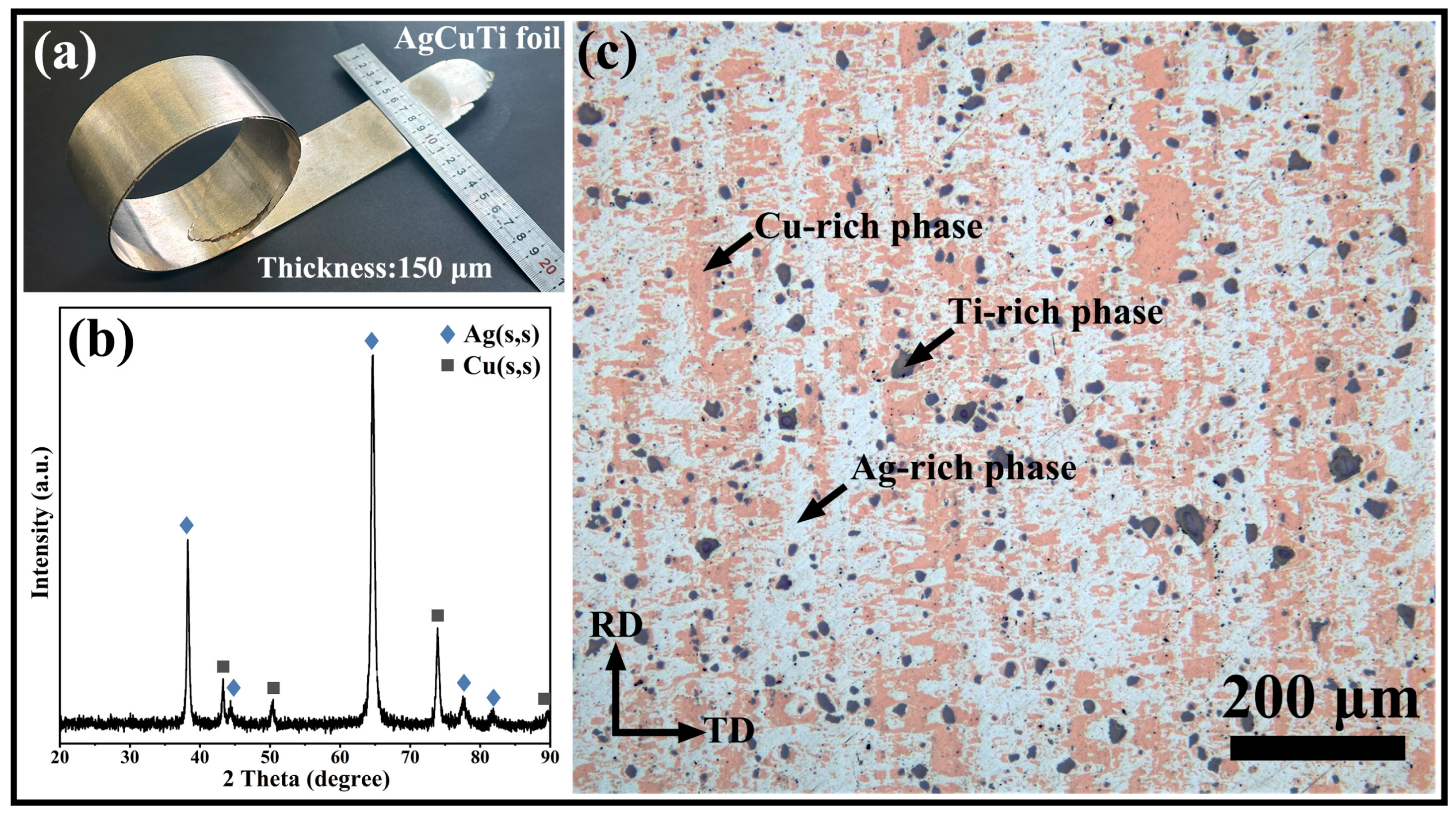
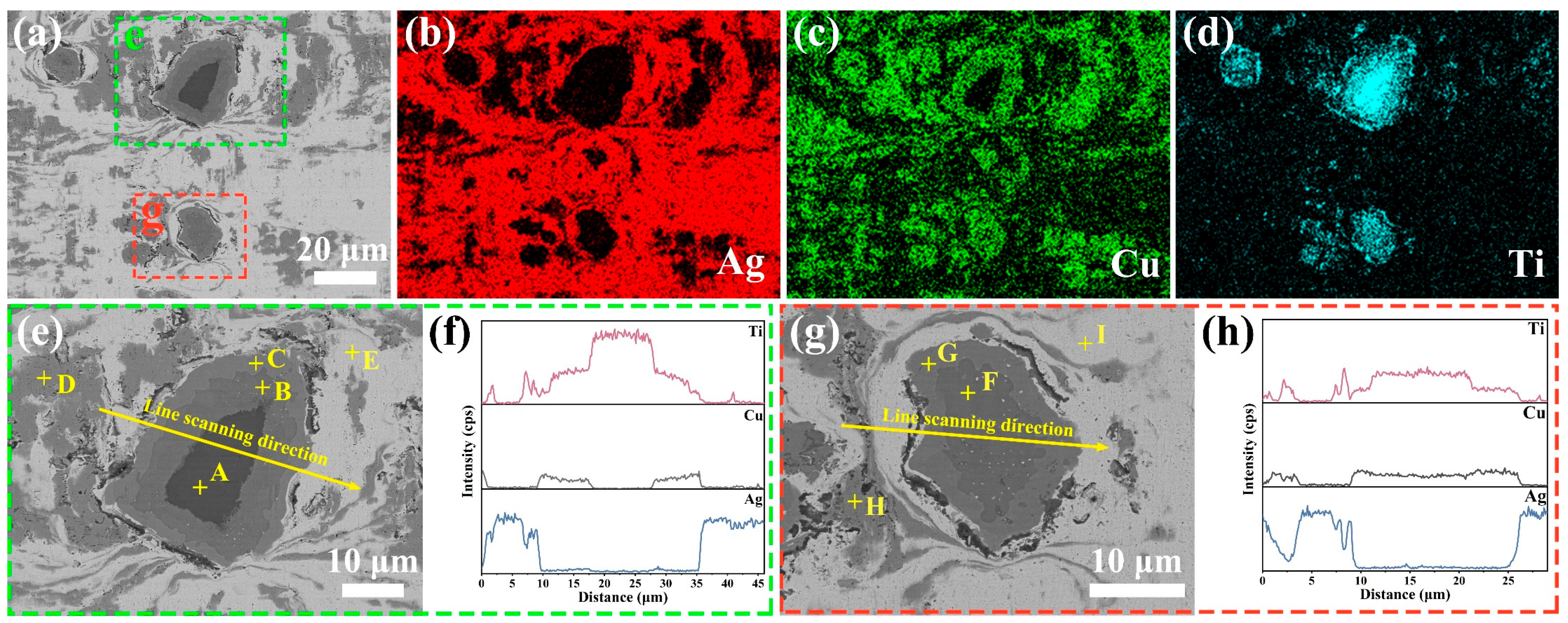

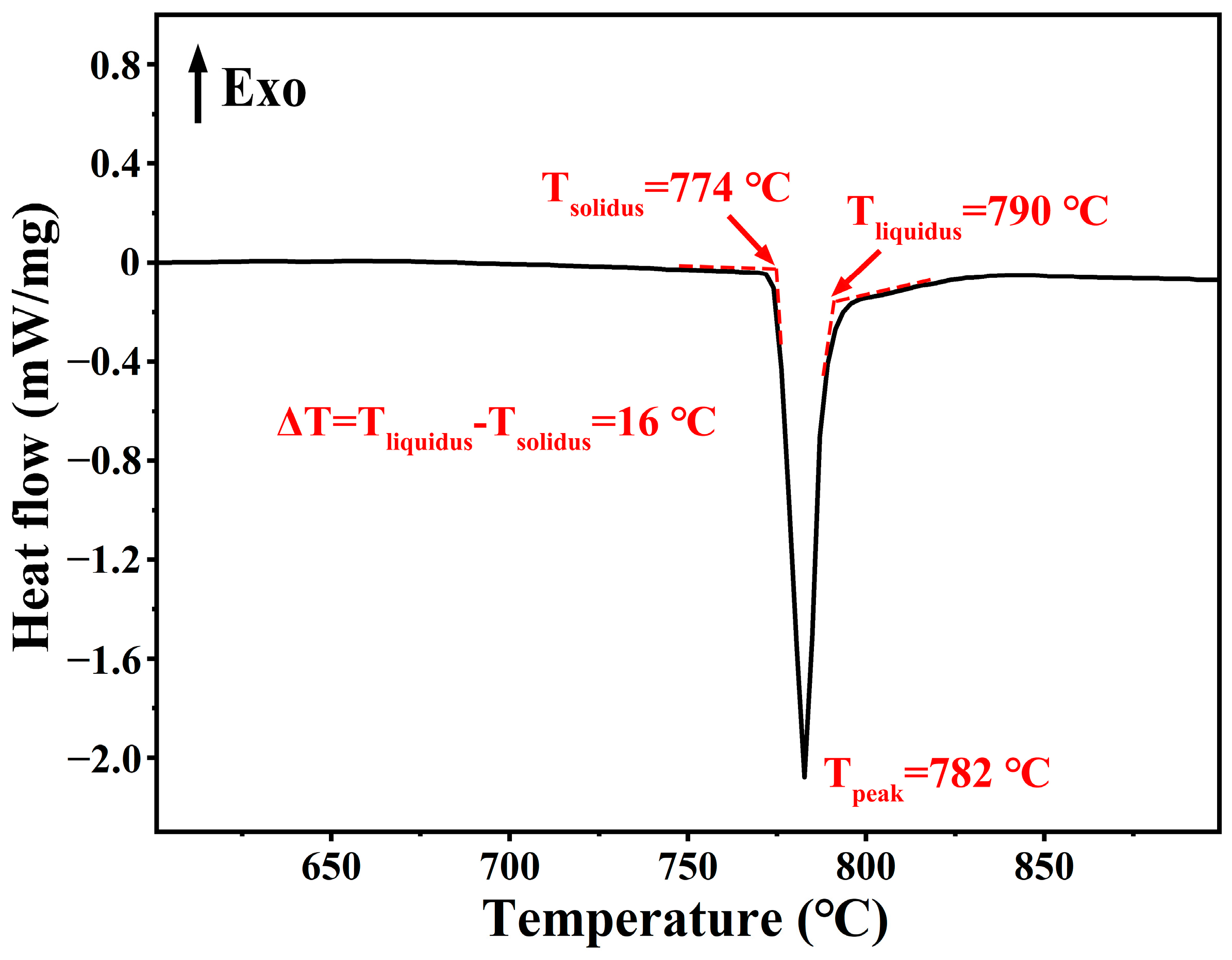

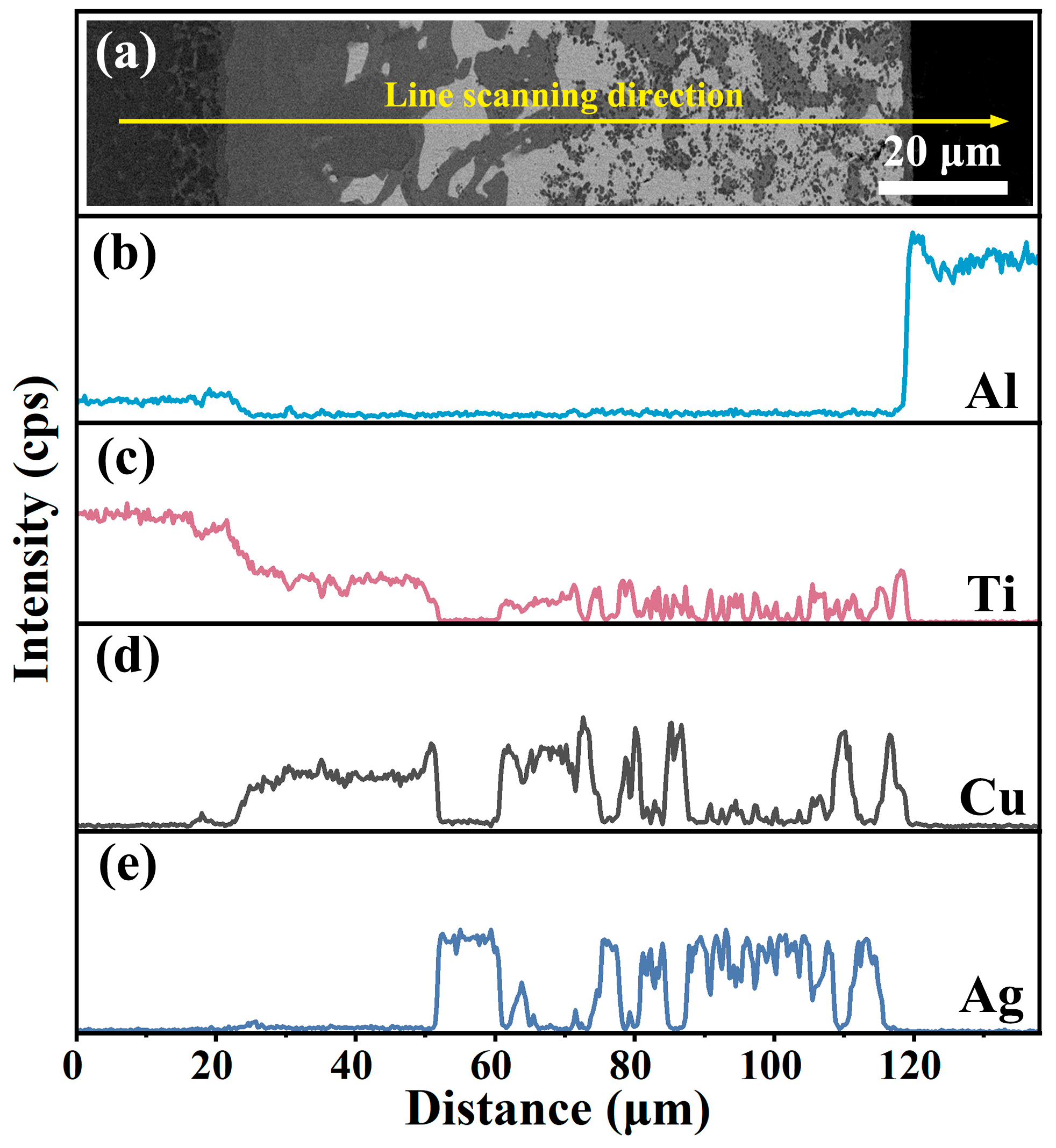

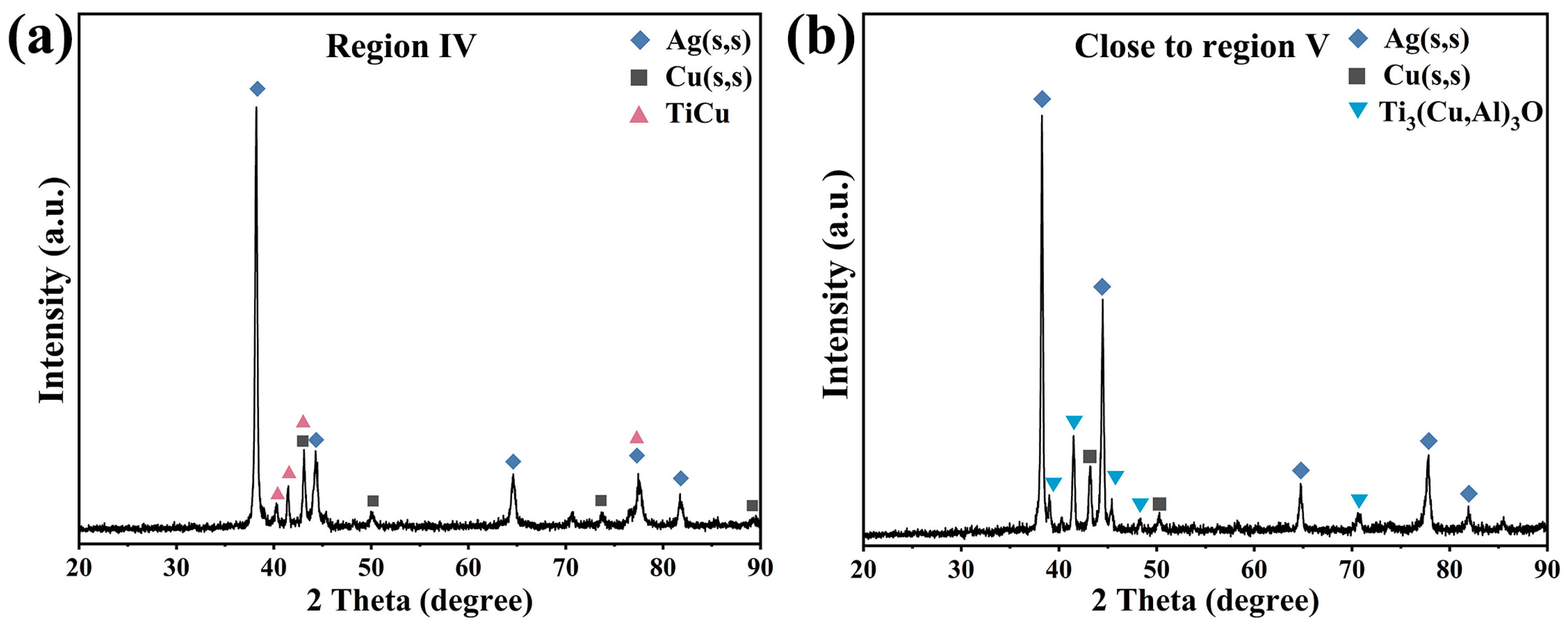
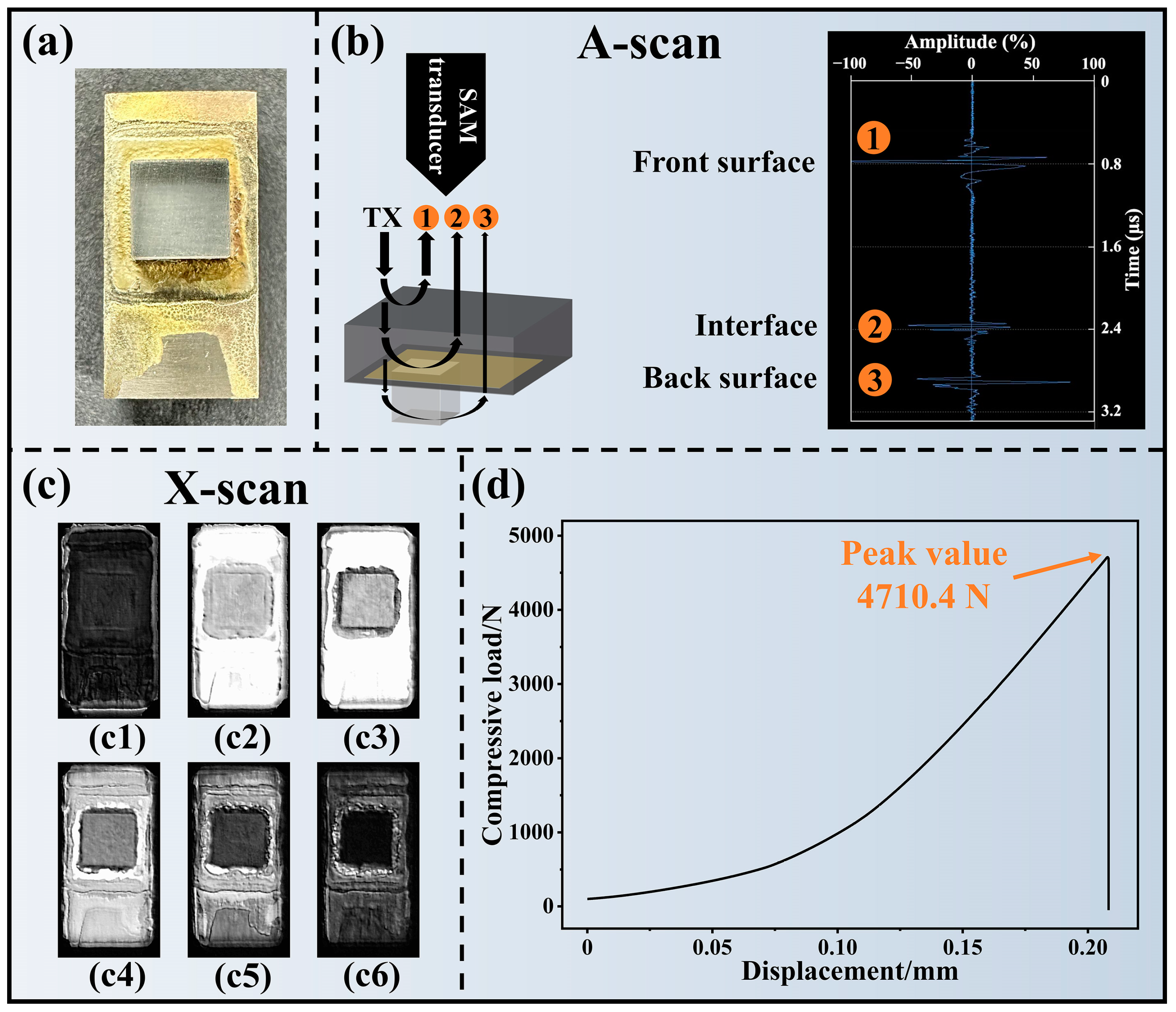
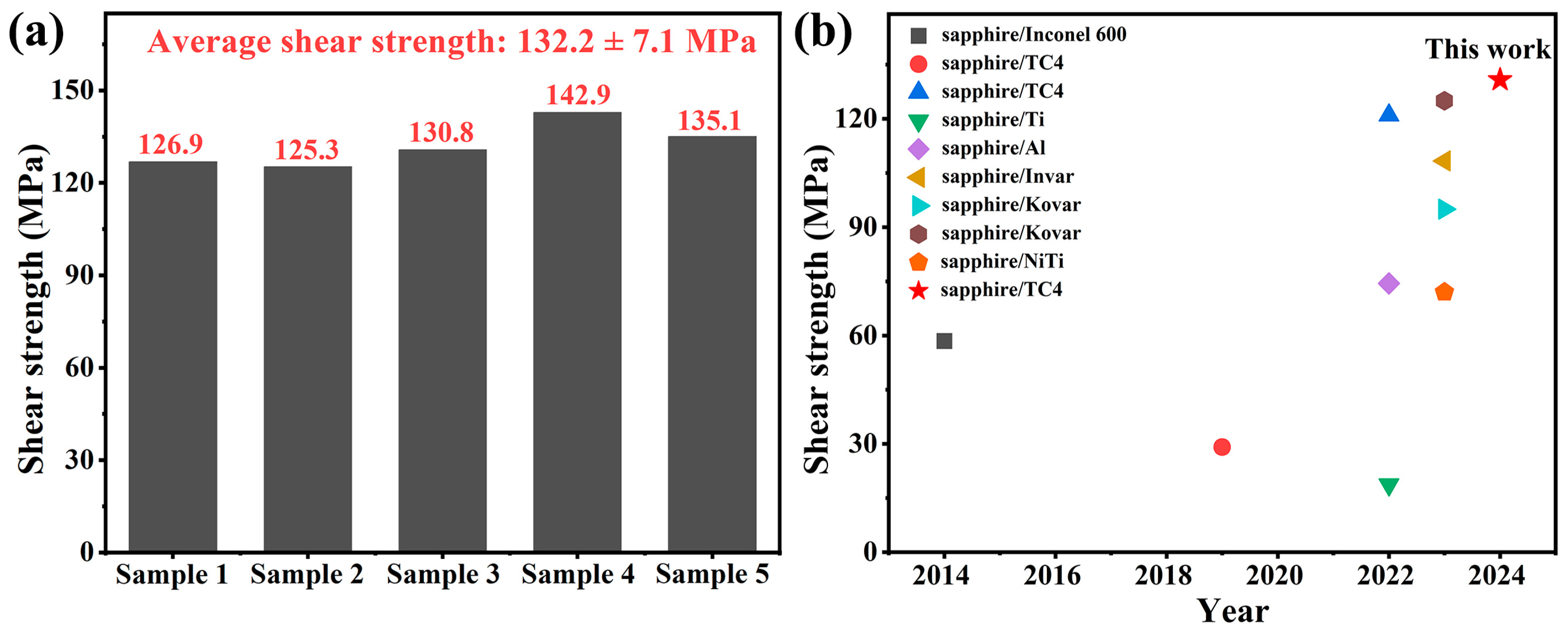
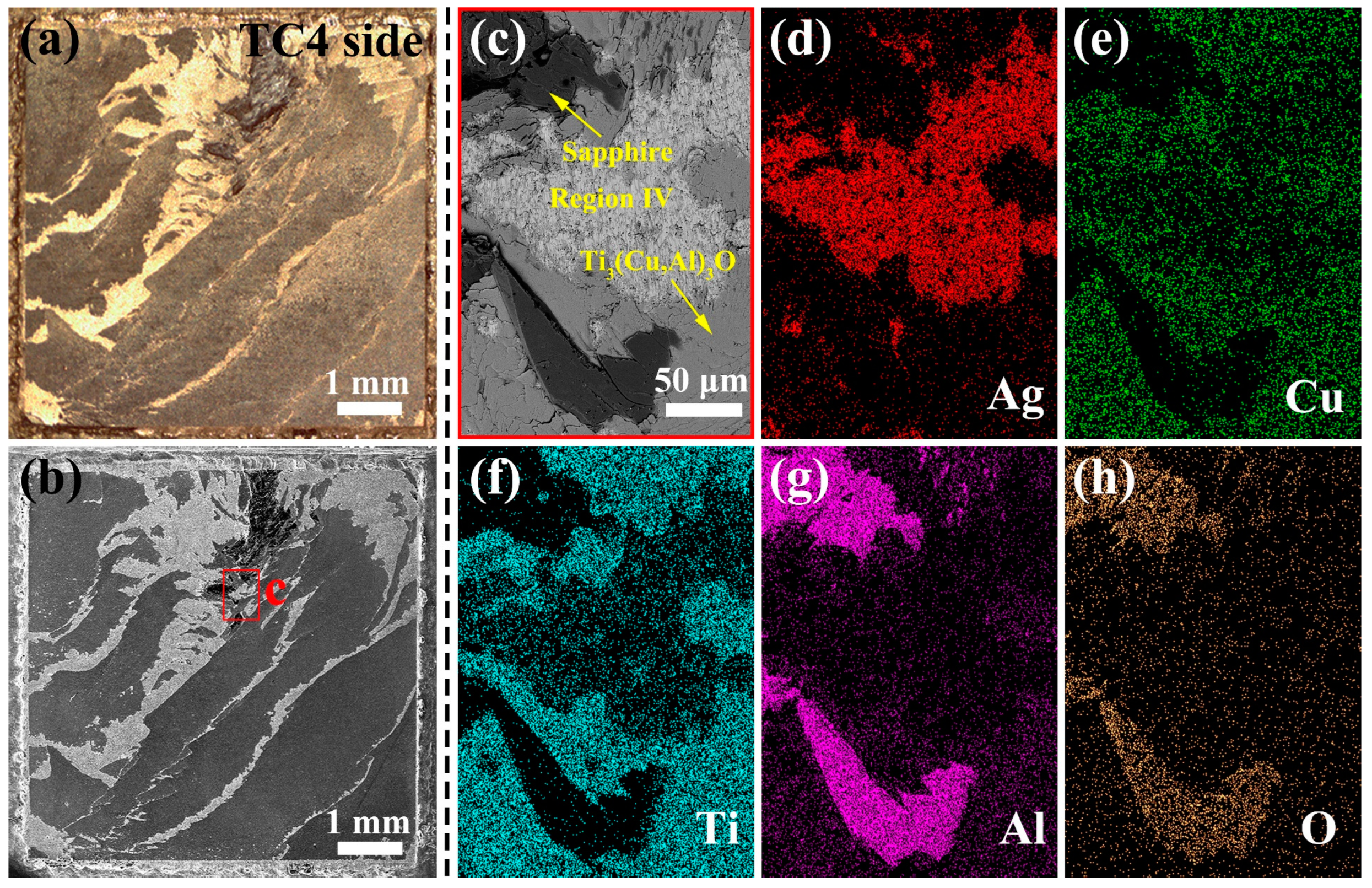

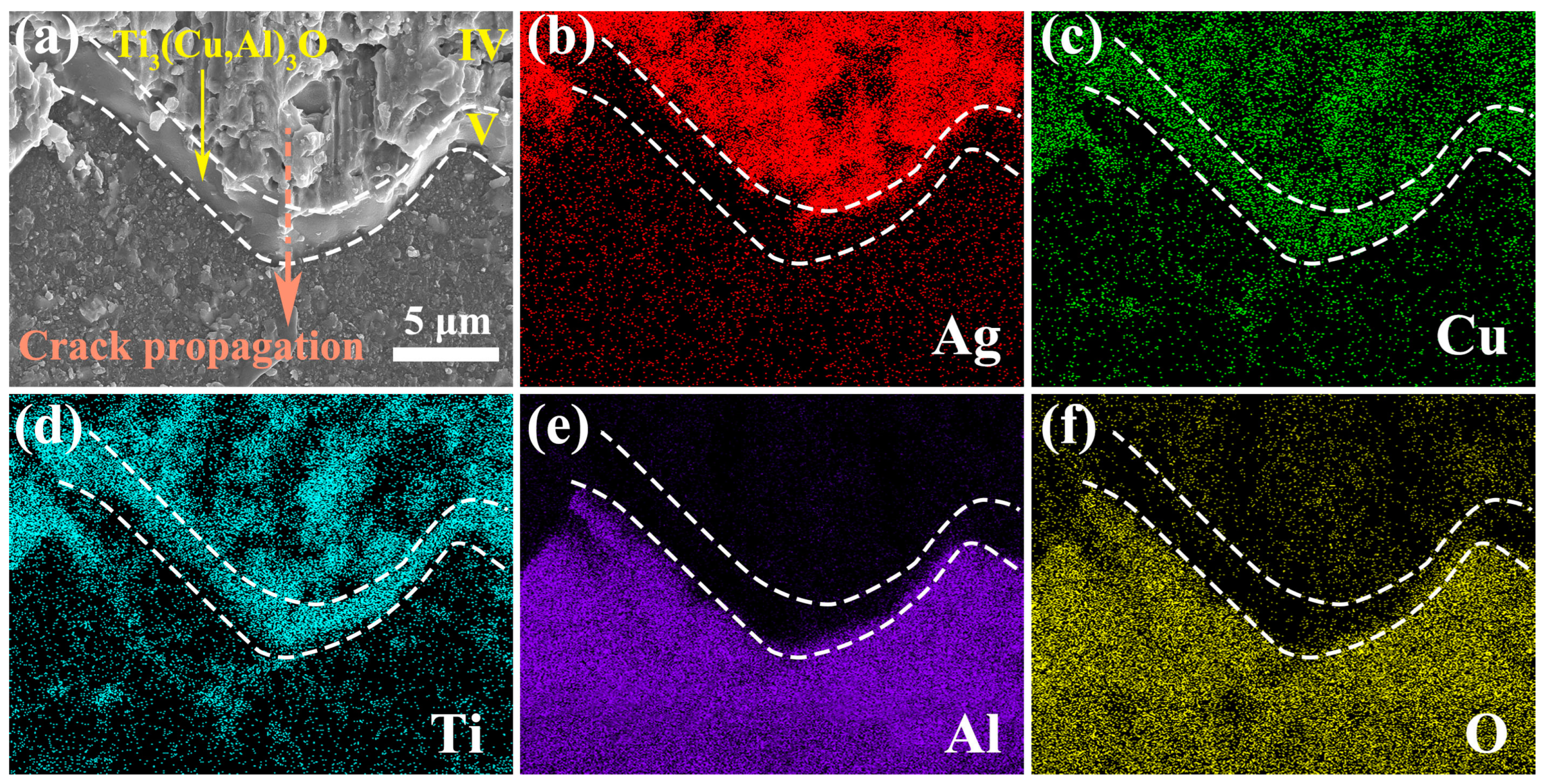

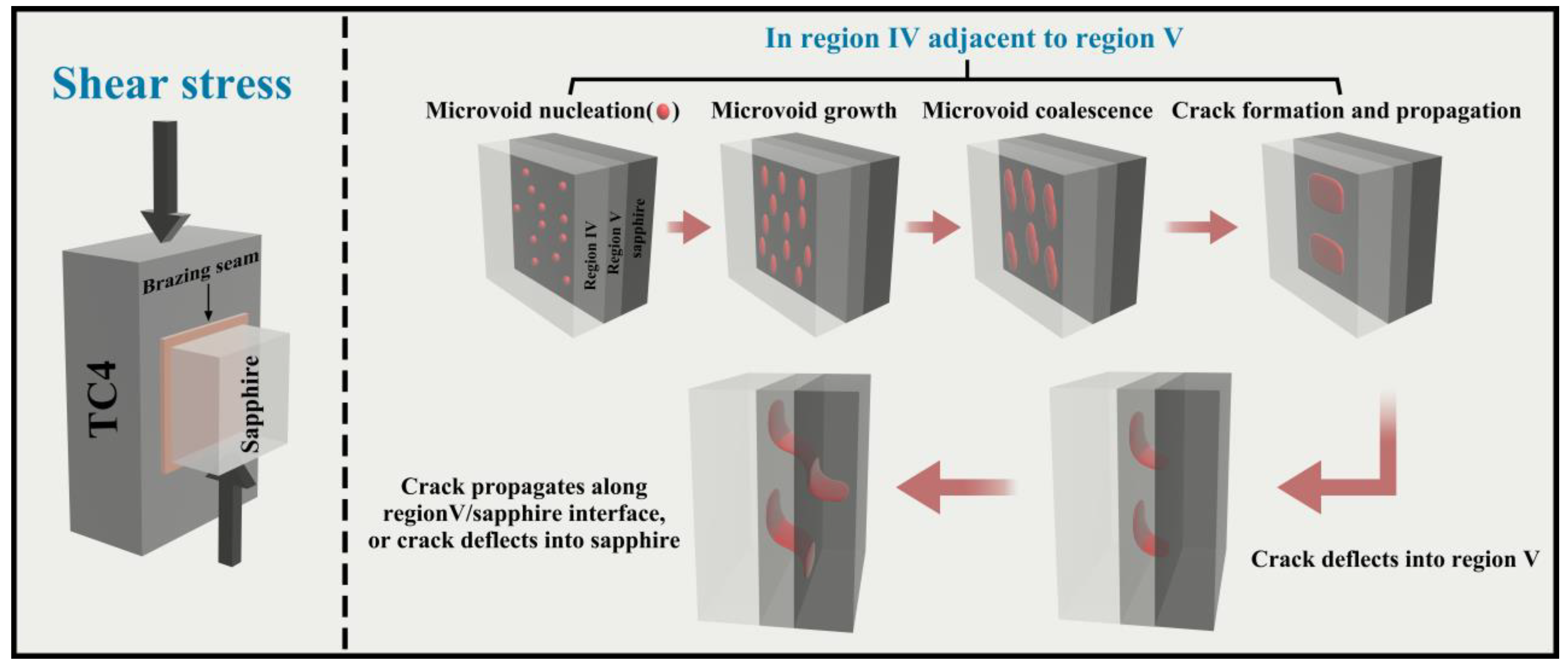
| EDS Spot | Ag | Cu | Ti | Possible Phase |
|---|---|---|---|---|
| Figure 4e, point A | - | 0.91 | 99.09 | Ti |
| Figure 4e, point B | 0.17 | 49.33 | 50.50 | TiCu |
| Figure 4e, point C | 1.25 | 77.43 | 21.32 | TiCu4 |
| Figure 4e, point D | 7.25 | 92.75 | - | Cu(s,s) |
| Figure 4e, point E | 93.26 | 6.74 | - | Ag(s,s) |
| Figure 4g, point F | 2.19 | 52.69 | 45.12 | TiCu |
| Figure 4g, point G | 0.64 | 78.99 | 20.37 | TiCu4 |
| Figure 4g, point H | 8.44 | 87.82 | 3.74 | Cu(s,s) |
| Figure 4g, point I | 92.79 | 7.21 | - | Ag(s,s) |
| EDS Spot | Ag | Cu | Ti | Al | V | O | Possible Phase | Region |
|---|---|---|---|---|---|---|---|---|
| Figure 9a, point A | 0.53 | 3.93 | 67.61 | 8.88 | 13.37 | 5.68 | α-β Ti | I |
| Figure 9a, point B | 1.78 | 29.07 | 62.93 | 5.17 | 1.05 | - | Ti2Cu | II |
| Figure 9a, point C | 1.56 | 55.79 | 42.52 | 0.13 | - | - | Ti3Cu4 | II |
| Figure 9a, point D | 1.25 | 58.23 | 37.78 | 2.74 | - | - | Ti2Cu3 | II |
| Figure 9a, point E | 1.31 | 46.34 | 45.68 | 0.59 | 1.79 | 4.29 | TiCu | III |
| Figure 9a, point F | 1.62 | 77.53 | 20.85 | - | - | - | TiCu4 | III |
| Figure 9a, point G | 89.59 | 10.41 | - | - | - | - | Ag(s,s) | III |
| Figure 9b, point H | 2.88 | 94.26 | 2.86 | - | - | - | Cu(s,s) | IV |
| Figure 9b, point I | 1.46 | 52.44 | 45.55 | 0.55 | - | - | TiCu | IV |
| Figure 9b, point J | 91.26 | 8.74 | - | - | - | - | Ag(s,s) | IV |
| Figure 9c, point K | 0.30 | 26.20 | 44.95 | 11.01 | 0.84 | 16.70 | Ti3(Cu,Al)3O | V |
| System | Joining Technique | Shear Strength | Year | Ref. |
|---|---|---|---|---|
| Sapphire/Inconel 600 | Brazing | 58.5 MPa | 2014 | [36] |
| Sapphire/TC4 | Brazing | 29.1 MPa | 2019 | [37] |
| Sapphire/TC4 | Diffusion bonding | 121 MPa | 2022 | [38] |
| Sapphire/Ti | Brazing | 18.7 MPa | 2022 | [39] |
| Sapphire/Al | Ultrasonic soldered | 74.42 MPa | 2022 | [40] |
| Sapphire/Invar | Femtosecond laser micro-welding | 108.35 MPa | 2023 | [41] |
| Sapphire/Kovar | Brazing | 95 MPa | 2023 | [23] |
| Sapphire/Kovar | Brazing | 125 MPa | 2023 | [32] |
| Sapphire/NiTi | Transient liquid phase bonding | 72 MPa | 2023 | [42] |
| Sapphire/TC4 | Brazing | 132.2 MPa | 2024 | This work |
Disclaimer/Publisher’s Note: The statements, opinions and data contained in all publications are solely those of the individual author(s) and contributor(s) and not of MDPI and/or the editor(s). MDPI and/or the editor(s) disclaim responsibility for any injury to people or property resulting from any ideas, methods, instructions or products referred to in the content. |
© 2024 by the authors. Licensee MDPI, Basel, Switzerland. This article is an open access article distributed under the terms and conditions of the Creative Commons Attribution (CC BY) license (https://creativecommons.org/licenses/by/4.0/).
Share and Cite
Liu, S.; Liu, H.; Zhou, L.; Cui, H.; Liu, M.; Chen, L.; Wen, M.; Dong, H.; Liu, F.; Wang, W.; et al. Specially Structured AgCuTi Foil Enables High-Strength and Defect-Free Brazing of Sapphire and Ti6Al4V Alloys: The Microstructure and Fracture Characteristics. Materials 2024, 17, 3812. https://doi.org/10.3390/ma17153812
Liu S, Liu H, Zhou L, Cui H, Liu M, Chen L, Wen M, Dong H, Liu F, Wang W, et al. Specially Structured AgCuTi Foil Enables High-Strength and Defect-Free Brazing of Sapphire and Ti6Al4V Alloys: The Microstructure and Fracture Characteristics. Materials. 2024; 17(15):3812. https://doi.org/10.3390/ma17153812
Chicago/Turabian StyleLiu, Shaohong, Hairui Liu, Limin Zhou, Hao Cui, Manmen Liu, Li Chen, Ming Wen, Haigang Dong, Feng Liu, Wei Wang, and et al. 2024. "Specially Structured AgCuTi Foil Enables High-Strength and Defect-Free Brazing of Sapphire and Ti6Al4V Alloys: The Microstructure and Fracture Characteristics" Materials 17, no. 15: 3812. https://doi.org/10.3390/ma17153812





